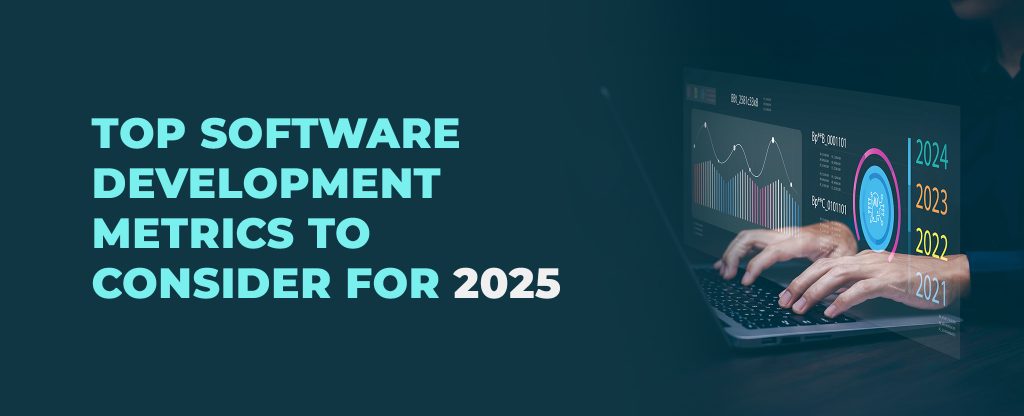The Ultimate Guide to Latest Tech Trends in Software Development 2025
7 Nov 25 


In today’s fast-paced business world, companies are racing to stay ahead by embracing the latest tech trends in software dev. A whopping 63% of Forbes Global 2000 CEOs believe that software development and digital innovation are crucial for future success. But with emerging software technologies evolving at breakneck speed, from AI-driven automation to cloud software trends and DevOps trends, how do businesses keep pace?
The rapid growth of AI, machine learning, and data science is fueling digital transformation efforts through innovative software solutions. Whether you’re exploring AI software trends, implementing cloud-native architectures, or modernizing your development pipeline with DevOps practices, understanding these shifts is essential.
This comprehensive guide breaks down the most critical emerging software technologies and market projections for 2025 and beyond, helping you make informed decisions about which tools and methodologies will drive your business forward.
Key Software Development Industry Insights
The software development sector is experiencing explosive growth, driven by organizations’ urgent need for digital transformation. Here’s what the numbers tell us:
Market & Investment Landscape:
- Global IT spending is set to hit $5 trillion in 2024, up nearly 8% from 2023
- The custom software development market is expected to grow at a CAGR of 22.5% (2024-2030), reaching $146.18 billion
- There are over 26.3 million software developers worldwide, with demand continuing to surge
- The global shortage of full-time software developers is predicted to jump from 1.4 million in 2021 to 4.0 million by 2025
Business Impact:
- Companies investing in software development have seen an average 20% revenue growth
- 84.7% of software development projects are for enterprise applications
- 83% of firms now use custom software, up from 62% in 2018
- Custom software can save 30-50% long-term vs. recurring license fees
Project Economics:
- Software development projects typically cost between $15,000 to $100,000 or more, depending on complexity
- 53.6% of software development projects focus on business automation
- 38.5% of software development projects are in the retail & e-commerce sector
Software Development Market Growth and Projections
The software development services market is experiencing unprecedented expansion. Understanding these growth trajectories is essential for businesses planning their tech investments.
Global Market Size:
- The global software development market was valued at about $659.01 billion in 2023 and is expected to exceed $898 billion by 2029
- The industry is projected to grow at a CAGR of 26.67% from 2024 to 2029
- Enterprise software market is expected to reach $401.60 billion by 2029, growing at 6.35% CAGR
Regional Opportunities:
- India is the top choice for 80% of US and European firms outsourcing IT work
- Half of Fortune 500 companies outsource software projects to Indian IT firms
- South Korea, USA, Germany, Japan and UK are leaders in adopting cutting-edge software solutions
As businesses continue to digitize and automate their operations, the demand for skilled software developers and innovative solutions is set to soar. By staying informed about these trends, you can position your business to take advantage of the opportunities presented by the evolving software development landscape.
Why Invest in Business Software Development?
In today’s competitive landscape, software is essential for streamlining operations and boosting revenue. Here’s why forward-thinking companies are investing heavily in software development:
Operational Excellence:
- 36% of companies use business process software for automation, with 29% planning to implement it within 3 years
- 25% of businesses saw accelerated growth after buying software; 58% had standard growth
- 75% of fast-growing companies will increase software spending in 2024, up from 60% in 2023
Customer Impact:
- 74% of businesses using CRM report stronger customer relationships
- 70% of large companies use ERP software; 53% see positive ROI
- 73% of warehouses plan to adopt mobile inventory management solutions
Cost Efficiency:
- Custom software can reduce operational costs by 30-50% long-term compared to recurring license fees
Latest Tech Trends in Software Development: A Comprehensive Overview
The latest tech trends in software dev are fundamentally reshaping how organizations build, deploy, and maintain applications. Let’s explore the key technologies driving this transformation.
The Rising Impact of AI and Emerging Technologies
AI Software Trends represent one of the most significant shifts in the industry:
- AI market in software development to reach $126 billion by 2025
- 63% of businesses using AI report increased productivity
- 80% of enterprises have AI projects in production
- Machine learning market to hit $117 billion by 2027, growing at 39% CAGR
- 85% of businesses see big data as a game-changer
These AI software trends demonstrate that artificial intelligence is no longer experimental—it’s become a core business imperative for competitive advantage.
IoT and Blockchain: Emerging Software Technologies
Beyond AI, several emerging software technologies are gaining traction:
- IoT software market to reach $528 billion by 2027, with 35% of manufacturers using IoT data to optimize operations
- Blockchain in software development market to hit $469 million by 2025
- These technologies enable new business models and operational efficiencies
Cloud Software Trends: Modern Infrastructure Solutions
Cloud computing has fundamentally transformed how software is built and deployed. Understanding current cloud software trends is critical for modern development strategies.
Market Growth & Adoption:
- The global cloud computing market is projected to exceed $1.26 trillion by 2028, growing at a 15.1% CAGR
- Gartner predicts that by 2025, over 95% of digital workloads will run on cloud-native platforms, up 30% from 2021
- 94% of enterprises use cloud services, making cloud adoption virtually universal
Organizations looking to modernize their infrastructure should explore comprehensive cloud development services tailored to their specific needs.
Business Benefits of Cloud-Based Development:
- Cloud computing can boost app development and maintenance productivity by 38%, while reducing infrastructure costs by 29%
- Fortune 500 companies have increased their cloud-based applications from 10% to 60%, generating $56 billion in development and maintenance revenue
- Implementing resilient cloud infrastructure can cut downtime by 57% and reduce breach-related costs by 26%
Cloud Platform Trends:
- AWS maintains its lead, used by 48.62% of cloud engineers
- Microsoft Azure (26.03%) and Google Cloud (23.86%) follow in popularity
These cloud software trends underscore the critical importance of cloud-native architectures for scalable, efficient software solutions.
AI Software Trends: The Intelligence Revolution
AI software trends are reshaping enterprise software development with unprecedented speed. Organizations that understand and leverage these trends will gain significant competitive advantages.
AI Market Expansion
The AI software trends showcase remarkable market momentum:
- Gartner forecasts global AI software spending to reach $297.9 billion by 2027, growing at a 19.1% CAGR over 5 years
- Generative AI (GenAI) is expected to account for 35% of AI software spending by 2027, up from 8% in 2023
- By 2026, an estimated 70% of independent software vendors will incorporate GenAI into their enterprise applications
- Overall AI software growth is projected at 20.4% by 2027
Business Process Automation Through AI
AI software trends are also driving automation revolution:
- Cloud-based Business Process Automation (BPA) software is set to reach $41.8 billion by 2025, growing at an 11.8% CAGR
- 36% of organizations globally already use business process management software for workflow automation
- 31% of businesses favor automation software for its potential labor cost savings
Data Analytics and AI Integration
Organizations leveraging data analytics alongside AI are seeing dramatic results:
- Organizations leveraging data analytics are 23 times more likely to acquire customers, 6 times more likely to retain them, and 19 times more profitable
- Big data analytics can improve strategic decision-making by 69%, optimize operational processes by 54%, and enhance customer understanding by 52%
- Over 40% of businesses worldwide are harnessing the power of big data analytics
DevOps Trends and Best Practices
DevOps trends represent a fundamental shift in how organizations approach software delivery, breaking down silos between development and operations teams. Understanding current DevOps trends is essential for competitive software development.
Why DevOps is Critical Now
DevOps trends are reshaping the competitive landscape:
- A whopping 86% of organizations worldwide consider DevOps crucial for gaining a competitive edge
- Over 80% of organizations actively practice DevOps, with adoption expected to reach 94% in coming years
- High-performing organizations can achieve a 2,555-times boost in deployment efficiency using DevOps practices
Key DevOps Practices and Metrics
Current DevOps trends emphasize:
- DevOps engineers spend 54% of their time on code observability, monitoring, and security
- Continuous integration and continuous deployment (CI/CD) pipelines are becoming standard practice
- Infrastructure as Code (IaC) is enabling faster, more reliable deployments
- Container orchestration with Kubernetes is becoming mainstream
Choosing Development Methodologies That Align with DevOps
When it comes to software development approaches, many businesses now prefer agile methodologies combined with DevOps trends for their numerous benefits:
Agile Methodologies:
- Nearly two-thirds (64%) of companies have adopted Agile methodologies to enhance software delivery
- 60% of businesses using Agile have seen improvements in team productivity and revenue growth
- 71% of businesses prefer Agile over the waterfall model
DevOps Integration:
- DevOps practices complement Agile, enabling faster iteration cycles and more reliable releases
- Organizations combining Agile and DevOps trends see significantly faster time-to-market
Programming Languages and Emerging Technologies
To create innovative software solutions, it’s crucial to stay informed about emerging software technologies and language trends that are shaping development practices.
Frontend and Full-Stack Development
- JavaScript remains the most popular language among developers, with a 63.61% preference rate
- HTML/CSS forms the foundation for frontend development, used by 52.97% of developers
- Node.js has surpassed React, now preferred by 42.65% of developers for backend work
- React follows closely with a 40.58% preference rate for frontend applications
Backend and Database Technologies
- Python leads in backend and modern-edge applications, preferred by 49.28% of software engineers
- For database query languages, PostgreSQL tops the list with a 45.55% preference rate
- Following PostgreSQL are MySQL (41.09%), SQLite (30.9%), and MongoDB (25.52%)
Emerging Stack Considerations
When selecting your tech stack, consider these factors alongside emerging software technologies:
- Scalability and performance requirements
- Development team expertise
- Integration capabilities with existing systems
- Long-term maintenance and support needs
- Cost considerations
Software Development Landscape: A Global Perspective
The software development industry continues to evolve globally, with distinct regional patterns shaping how latest tech trends in software dev are adopted.
Global Developer Population:
- Approximately 26.3 million software developers worldwide
- This number may exceed 28.7 million in the coming years
Work Environment Trends:
- 41.41% work remotely
- 42.18% in hybrid setups
- 16.41% fully office-based
- 59% of remote developers report higher productivity
Industry-Specific Software Development Trends
Different industries are leveraging the latest tech trends in software dev in unique ways. Understanding these sector-specific applications of emerging software technologies and AI software trends helps maximize value.
Healthcare: AI-Powered Digital Transformation
The healthcare industry exemplifies how AI software trends and emerging software technologies transform operations:
- The global telemedicine market is projected to reach $503.8 billion by 2032, growing at a CAGR of 16.4%
- AI in healthcare is experiencing explosive growth, with the software segment expected to expand from $11.7 billion to $281.2 billion by 2032
- 48% of healthcare and pharma companies plan to invest in GenAI solutions by 2025
- In drug discovery, AI solutions can potentially reduce time and costs by 25-50%
Banking & Finance: Fintech Innovation
The fintech sector demonstrates rapid adoption of latest tech trends in software development:
- The fintech market cap is expected to reach $1.5 trillion by 2030
- The global neobanking market is forecasted to generate $364.6 billion in revenue by 2026
- Mobile banking market size is projected to exceed $3.19 billion by 2031, up from $1.13 billion in 2022
Retail & Ecommerce: AI and Personalization
Retailers are leveraging AI software trends and cloud software trends for competitive advantage:
- The global eCommerce software market is projected to hit $9.75 billion by 2029
- AI and ML implementation in retail has shown an 8.1% increase in revenue in 2023-2024, compared to just 3.1% for non-adopters
- Retail management systems software is expected to reach $6.8 billion by 2031
Supply Chain & Logistics: Data-Driven Operations
Supply chain optimization demonstrates the impact of emerging software technologies:
- The supply chain management software market is expected to reach $24.65 billion by 2029, growing at a CAGR of 4.13%
- 43% of supply chain businesses have digitized their operations, boosting annual revenue growth by 2.3%
- The warehouse management system market is forecasted to grow to $13.34 billion by 2030, with a CAGR of 19.5%
Software Development Challenges
Despite the exciting opportunities presented by latest tech trends in software dev, developers face significant obstacles:
- 68% report unexpected challenges in nearly half of their projects
- 57% struggle with unclear requirements from clients or project management teams
- 55% of projects are affected by last-minute changes
- 52% find choosing the right technology and tools challenging
- 50% of development teams experience collaboration issues due to remote work arrangements
- 13% of businesses find it difficult to hire software developers that meet their specific needs
Addressing these challenges requires investing in tools, processes, and talent that align with DevOps trends and modern development practices.
Future Possibilities in Software Development
The future of software development is being shaped by accelerating adoption of emerging software technologies, latest tech trends in software dev, and AI software trends.
Enterprise Software Expansion:
- The enterprise software market is set to reach $344.4 billion in revenue by 2027
- Application development software is expected to hit $217 billion
- System infrastructure software will reach $156.4 billion
AI-Driven Growth:
- The global AI software development market is projected to grow at a CAGR of 22.97%, reaching $1,094.52 billion by 2032
- Spending on Generative AI in software development is forecasted to surge from $41 billion in 2023 to $287.4 billion by 2033
DevOps and Cloud Maturation:
- Cloud software trends and DevOps trends will continue driving efficiency gains
- Adoption of DevOps practices is expected to reach 94% by 2026
Wrapping Up
The software development field is in constant flux, driven by rapidly evolving latest tech trends in software dev, emerging software technologies, and transformative AI software trends. Understanding cloud software trends, DevOps trends, and sector-specific implementations of these technologies is no longer optional,it’s essential for business survival and growth.
Organizations that stay informed about these trends, invest in the right talent and tools, and adopt modern development methodologies like Agile combined with DevOps will be best positioned to thrive in this competitive landscape.
Mindster specializes in building cutting-edge software solutions that leverage the latest tech trends in software development—from AI-powered applications to cloud-native architectures and DevOps-optimized delivery pipelines.
Whether you’re looking to modernize your tech stack, accelerate your digital transformation, or build innovative solutions that leverage AI and emerging technologies, our expert team is ready to help.
Get in Touch with Mindster Today – Let’s discuss how we can help your organization stay competitive in this rapidly evolving software development landscape.
- Agentic AI1
- Android Development3
- Artificial Intelligence31
- Classified App3
- Custom App Development5
- Digital Transformation12
- Doctor Appointment Booking App14
- Dropshipping1
- Ecommerce Apps40
- Education Apps2
- Fintech-Apps37
- Fitness App4
- Flutter4
- Flutter Apps20
- Food Delivery App5
- Grocery App Development1
- Grocery Apps3
- Health Care10
- IoT2
- Loyalty Programs9
- Matrimony Apps1
- Microsoft1
- Mobile App Maintenance2
- Mobile Apps127
- Product Engineering6
- Progressive Web Apps1
- React Native Apps2
- Saas Application2
- Shopify9
- Software Development3
- Taxi Booking Apps7
- Truck Booking App5
- UI UX Design8
- Uncategorized6
- Web App Development1

















Comments